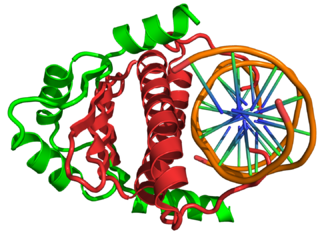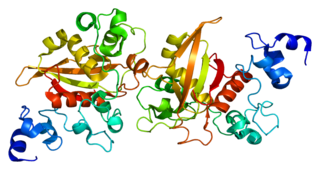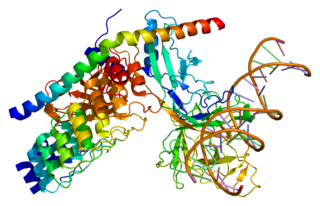Related Research Articles

MyoD, also known as myoblast determination protein 1, is a protein in animals that plays a major role in regulating muscle differentiation. MyoD, which was discovered in the laboratory of Harold M. Weintraub, belongs to a family of proteins known as myogenic regulatory factors (MRFs). These bHLH transcription factors act sequentially in myogenic differentiation. Vertebrate MRF family members include MyoD1, Myf5, myogenin, and MRF4 (Myf6). In non-vertebrate animals, a single MyoD protein is typically found.

Mediator is a multiprotein complex that functions as a transcriptional coactivator in all eukaryotes. It was discovered in 1990 in the lab of Roger D. Kornberg, recipient of the 2006 Nobel Prize in Chemistry. Mediator complexes interact with transcription factors and RNA polymerase II. The main function of mediator complexes is to transmit signals from the transcription factors to the polymerase.

In the field of molecular biology, myocyte enhancer factor-2 (Mef2) proteins are a family of transcription factors which through control of gene expression are important regulators of cellular differentiation and consequently play a critical role in embryonic development. In adult organisms, Mef2 proteins mediate the stress response in some tissues. Mef2 proteins contain both MADS-box and Mef2 DNA-binding domains.

The nuclear receptor co-repressor 2 (NCOR2) is a transcriptional coregulatory protein that contains several nuclear receptor-interacting domains. In addition, NCOR2 appears to recruit histone deacetylases to DNA promoter regions. Hence NCOR2 assists nuclear receptors in the down regulation of target gene expression. NCOR2 is also referred to as a silencing mediator for retinoid or thyroid-hormone receptors (SMRT) or T3 receptor-associating cofactor 1 (TRAC-1).

Jagged1 (JAG1) is one of five cell surface proteins (ligands) that interact with four receptors in the mammalian Notch signaling pathway. The Notch Signaling Pathway is a highly conserved pathway that functions to establish and regulate cell fate decisions in many organ systems. Once the JAG1-NOTCH (receptor-ligand) interactions take place, a cascade of proteolytic cleavages is triggered resulting in activation of the transcription for downstream target genes. Located on human chromosome 20, the JAG1 gene is expressed in multiple organ systems in the body and causes the autosomal dominant disorder Alagille syndrome (ALGS) resulting from loss of function mutations within the gene. JAG1 has also been designated as CD339.

Neurogenic locus notch homolog protein 1(Notch 1) is a protein encoded in humans by the NOTCH1 gene. Notch 1 is a single-pass transmembrane receptor.

Retinoid X receptor alpha (RXR-alpha), also known as NR2B1 is a nuclear receptor that in humans is encoded by the RXRA gene.

Neurogenic locus notch homolog protein 2 is a protein that in humans is encoded by the NOTCH2 gene.

Mediator of RNA polymerase II transcription subunit 1 also known as DRIP205 or Trap220 is a subunit of the Mediator complex and is a protein that in humans is encoded by the MED1 gene. MED1 functions as a nuclear receptor coactivator.

Recombination signal binding protein for immunoglobulin kappa J region is a protein that in humans is encoded by the RBPJ gene.

Cell division protein kinase 8 is an enzyme that in humans is encoded by the CDK8 gene.

Transcription factor HES1 is a protein that is encoded by the Hes1 gene, and is the mammalian homolog of the hairy gene in Drosophila. HES1 is one of the seven members of the Hes gene family (HES1-7). Hes genes code nuclear proteins that suppress transcription.

Mediator of RNA polymerase II transcription subunit 14 is an enzyme that in humans is encoded by the MED14 gene.

CREB-regulated transcription coactivator 1 (CRTC1), previously referred to as TORC1 (Transducer Of Regulated CREB activity 1), is a protein that in humans is encoded by the CRTC1 gene. It is expressed in a limited number of tissues that include fetal brain and liver and adult heart, skeletal muscles, liver and salivary glands and various regions of the adult central nervous system.

Mediator of RNA polymerase II transcription subunit 21 is an enzyme that in humans is encoded by the MED21 gene.

Thyroid hormone receptor-associated protein 3 is a protein that in humans is encoded by the THRAP3 gene.

Mastermind-like protein 1 is a protein that in humans is encoded by the MAML1 gene.

Mastermind-like protein 2 is a protein that in humans is encoded by the MAML2 gene.
The Epstein–Barr virus nuclear antigen 2 (EBNA-2) is one of the six EBV viral nuclear proteins expressed in latently infected B lymphocytes is a transactivator protein. EBNA2 is involved in the regulation of latent viral transcription and contributes to the immortalization of EBV infected cells. EBNA2 acts as an adapter molecule that binds to cellular sequence-specific DNA-binding proteins, JK recombination signal-binding protein (RBP-JK), and PU.1 as well as working with multiple members of the RNA polymerase II transcription complex.

Notch proteins are a family of type 1 transmembrane proteins that form a core component of the Notch signaling pathway, which is highly conserved in metazoans. The Notch extracellular domain mediates interactions with DSL family ligands, allowing it to participate in juxtacrine signaling. The Notch intracellular domain acts as a transcriptional activator when in complex with CSL family transcription factors. Members of this type 1 transmembrane protein family share several core structures, including an extracellular domain consisting of multiple epidermal growth factor (EGF)-like repeats and an intracellular domain transcriptional activation domain (TAD). Notch family members operate in a variety of different tissues and play a role in a variety of developmental processes by controlling cell fate decisions. Much of what is known about Notch function comes from studies done in Caenorhabditis elegans (C.elegans) and Drosophila melanogaster. Human homologs have also been identified, but details of Notch function and interactions with its ligands are not well known in this context.
References
- ↑ McElhinny AS, Li JL, Wu L (September 2008). "Mastermind-like transcriptional co-activators: emerging roles in regulating cross talk among multiple signaling pathways". Oncogene. 27 (38): 5138–47. doi: 10.1038/onc.2008.228 . PMID 18758483.
- ↑ Kovall RA (September 2008). "More complicated than it looks: assembly of Notch pathway transcription complexes". Oncogene. 27 (38): 5099–109. doi:10.1038/onc.2008.223. PMID 18758478.
- ↑ Schroeter EH, Kisslinger JA, Kopan R (May 1998). "Notch-1 signalling requires ligand-induced proteolytic release of intracellular domain". Nature . 393 (6683): 382–6. doi:10.1038/30756. PMID 9620803. S2CID 4431882.
- ↑ Wilson JJ, Kovall RA (March 2006). "Crystal structure of the CSL-Notch-Mastermind ternary complex bound to DNA". Cell . 124 (5): 985–96. doi: 10.1016/j.cell.2006.01.035 . PMID 16530045. S2CID 9224353.
- ↑ Chiang MY, Xu ML, Histen G, Shestova O, Roy M, Nam Y, Blacklow SC, Sacks DB, Pear WS, Aster JC (August 2006). "Identification of a conserved negative regulatory sequence that influences the leukemogenic activity of NOTCH1". Mol. Cell. Biol. 26 (16): 6261–71. doi:10.1128/MCB.02478-05. PMC 1592797 . PMID 16880534.
- ↑ Wu L, Maillard I, Nakamura M, Pear WS, Griffin JD (November 2007). "The transcriptional coactivator Maml1 is required for Notch2-mediated marginal zone B-cell development". Blood. 110 (10): 3618–23. doi:10.1182/blood-2007-06-097030. PMC 2077311 . PMID 17699740.
- ↑ Liu H, Kennard S, Lilly B (February 2009). "NOTCH3 expression is induced in mural cells through an autoregulatory loop that requires endothelial-expressed JAGGED1". Circ. Res. 104 (4): 466–75. doi:10.1161/CIRCRESAHA.108.184846. PMC 2747310 . PMID 19150886.
- ↑ Wu L, Liu J, Gao P, Nakamura M, Cao Y, Shen H, Griffin JD (July 2005). "Transforming activity of MECT1-MAML2 fusion oncoprotein is mediated by constitutive CREB activation". EMBO J. 24 (13): 2391–402. doi:10.1038/sj.emboj.7600719. PMC 1173159 . PMID 15961999.
- ↑ Fryer CJ, White JB, Jones KA (November 2004). "Mastermind recruits CycC:CDK8 to phosphorylate the Notch ICD and coordinate activation with turnover". Mol. Cell. 16 (4): 509–20. doi: 10.1016/j.molcel.2004.10.014 . PMID 15546612.
- ↑ Shen H, McElhinny AS, Cao Y, Gao P, Liu J, Bronson R, Griffin JD, Wu L (March 2006). "The Notch coactivator, MAML1, functions as a novel coactivator for MEF2C-mediated transcription and is required for normal myogenesis". Genes Dev. 20 (6): 675–88. doi:10.1101/gad.1383706. PMC 1413284 . PMID 16510869.
- ↑ Zhao Y, Katzman RB, Delmolino LM, Bhat I, Zhang Y, Gurumurthy CB, Germaniuk-Kurowska A, Reddi HV, Solomon A, Zeng MS, Kung A, Ma H, Gao Q, Dimri G, Stanculescu A, Miele L, Wu L, Griffin JD, Wazer DE, Band H, Band V (April 2007). "The notch regulator MAML1 interacts with p53 and functions as a coactivator". J. Biol. Chem. 282 (16): 11969–81. doi: 10.1074/jbc.M608974200 . PMID 17317671.
- ↑ Alves-Guerra MC, Ronchini C, Capobianco AJ (September 2007). "Mastermind-like 1 Is a specific coactivator of beta-catenin transcription activation and is essential for colon carcinoma cell survival". Cancer Res. 67 (18): 8690–8. doi:10.1158/0008-5472.CAN-07-1720. PMID 17875709.